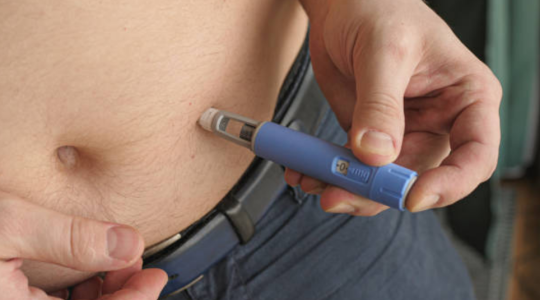Injections raise serious risk, reveal shocking side effects dangerous for seniors
By
Gian T
- Replies 0
If you’ve been keeping an eye on the latest health trends, you’ve probably heard about the so-called 'fat jabs'—weight-loss injections like Ozempic, Wegovy, and Mounjaro.
These medications, known as GLP-1 agonists, have been hailed as a game-changer for people struggling with obesity, with some clinical trials showing users can lose up to 20 per cent of their body weight.
But before you rush to your GP to ask about them, there’s a new warning that’s especially important for our community of over-60s: these drugs may come with a hidden and potentially dangerous side effect.
While the promise of rapid weight loss is tempting, doctors are now raising the alarm about what you might be losing along with the fat.
According to the Royal Osteoporosis Society (ROS), up to 40 per cent of the weight lost on these injections isn’t just fat—it’s also vital muscle and bone mass.
For older Australians, this is particularly concerning.
Losing muscle can make you weaker and less steady on your feet while losing bone density increases your risk of osteoporosis—a condition that makes bones brittle and much more likely to break.
As we age, our bones naturally become less dense, and our muscles shrink unless we actively work to maintain them.
Add a medication that accelerates this process, and you could be looking at a recipe for falls, fractures, and a loss of independence.
As we get older, our bodies are already fighting an uphill battle against muscle and bone loss.
Women, in particular, are at higher risk of osteoporosis, especially after menopause when oestrogen levels drop and bone loss speeds up.
For those who are already frail or have a history of fractures, the risks are even greater.
Professor Carl Heneghan from Oxford University’s Centre for Evidence-Based Medicine put it bluntly: 'Any drug that reduces muscle mass and bone density is a bad idea for people who are frail and those vulnerable to fractures with osteoporosis.
The evidence is clear—these drugs carry significant risks, and the longer a patient stays on them, the greater the risk.'
With half a million people in the UK already taking these drugs (and numbers rising in Australia, too), it’s crucial to weigh the benefits against the risks.
While losing weight can certainly improve health outcomes for many, it’s not a one-size-fits-all solution—especially for older adults.
Dr Taher Mahmud, founder of the London Osteoporosis Clinic, emphasises the importance of a balanced diet and weight-bearing exercise for individuals considering or already taking GLP-1 agonists.
'It is essential that those taking GLP-1 agonists know about the importance of good nutrition and weight-bearing exercise,' he said.
This means making sure you’re getting enough protein, calcium, and vitamin D and staying active with activities like walking, gardening, or even light resistance training.
If you’re considering fat jabs, it’s important to speak with your doctor first—especially if you have a history of osteoporosis, fractures, or muscle weakness.
Ask how the injection might affect your bones and muscles and whether a bone density scan is recommended.
Support your body by eating a nutrient-rich diet and staying active with weight-bearing and resistance exercises.
If you experience new aches, pains, or weakness, report them to your doctor without delay.
Experts like Professor Heneghan argue that the focus should be on preventing obesity in the first place rather than relying on medications as a 'quick fix.'
For many, lifestyle changes—like eating a balanced diet, staying active, and maintaining a healthy weight—are still the safest and most effective way to protect your health as you age.
Remember, your health is your wealth—so let’s look after our bones and muscles as well as our waistlines!
 Have you or someone you know tried these weight-loss injections? Did you notice any changes in your strength or bone health? Are you worried about the risks, or do you think the benefits outweigh them? We’d love to hear your experiences and thoughts in the comments below.
Have you or someone you know tried these weight-loss injections? Did you notice any changes in your strength or bone health? Are you worried about the risks, or do you think the benefits outweigh them? We’d love to hear your experiences and thoughts in the comments below.
These medications, known as GLP-1 agonists, have been hailed as a game-changer for people struggling with obesity, with some clinical trials showing users can lose up to 20 per cent of their body weight.
But before you rush to your GP to ask about them, there’s a new warning that’s especially important for our community of over-60s: these drugs may come with a hidden and potentially dangerous side effect.
While the promise of rapid weight loss is tempting, doctors are now raising the alarm about what you might be losing along with the fat.
According to the Royal Osteoporosis Society (ROS), up to 40 per cent of the weight lost on these injections isn’t just fat—it’s also vital muscle and bone mass.
For older Australians, this is particularly concerning.
Losing muscle can make you weaker and less steady on your feet while losing bone density increases your risk of osteoporosis—a condition that makes bones brittle and much more likely to break.
As we age, our bones naturally become less dense, and our muscles shrink unless we actively work to maintain them.
Add a medication that accelerates this process, and you could be looking at a recipe for falls, fractures, and a loss of independence.
As we get older, our bodies are already fighting an uphill battle against muscle and bone loss.
Women, in particular, are at higher risk of osteoporosis, especially after menopause when oestrogen levels drop and bone loss speeds up.
For those who are already frail or have a history of fractures, the risks are even greater.
Professor Carl Heneghan from Oxford University’s Centre for Evidence-Based Medicine put it bluntly: 'Any drug that reduces muscle mass and bone density is a bad idea for people who are frail and those vulnerable to fractures with osteoporosis.
The evidence is clear—these drugs carry significant risks, and the longer a patient stays on them, the greater the risk.'
While losing weight can certainly improve health outcomes for many, it’s not a one-size-fits-all solution—especially for older adults.
Dr Taher Mahmud, founder of the London Osteoporosis Clinic, emphasises the importance of a balanced diet and weight-bearing exercise for individuals considering or already taking GLP-1 agonists.
'It is essential that those taking GLP-1 agonists know about the importance of good nutrition and weight-bearing exercise,' he said.
This means making sure you’re getting enough protein, calcium, and vitamin D and staying active with activities like walking, gardening, or even light resistance training.
If you’re considering fat jabs, it’s important to speak with your doctor first—especially if you have a history of osteoporosis, fractures, or muscle weakness.
Support your body by eating a nutrient-rich diet and staying active with weight-bearing and resistance exercises.
If you experience new aches, pains, or weakness, report them to your doctor without delay.
Experts like Professor Heneghan argue that the focus should be on preventing obesity in the first place rather than relying on medications as a 'quick fix.'
For many, lifestyle changes—like eating a balanced diet, staying active, and maintaining a healthy weight—are still the safest and most effective way to protect your health as you age.
Remember, your health is your wealth—so let’s look after our bones and muscles as well as our waistlines!
Key Takeaways
- Doctors are warning that using weight-loss injections such as Ozempic, Wegovy, and Mounjaro could increase the risk of osteoporosis and bone fractures, especially in the elderly and frail.
- Research shows up to 40 per cent of the weight lost from these fat jabs comes from vital muscle and bone mass, not just fat.
- Experts stress the importance of discussing the risks with a doctor, as losing muscle and bone can impair strength, stability, and independence—particularly for women and those already at risk of osteoporosis.
- Maintaining good nutrition and doing weight-bearing exercise is essential for anyone taking GLP-1 agonists to help protect muscle and bone health.








